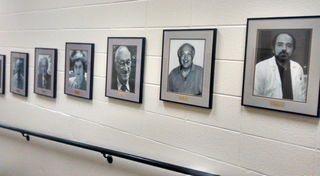Bias
Confronting a Toxic Racial Climate
Improving harmful race relations on campuses is not easy but necessary.
Posted January 30, 2016

Racial conflict at universities all over the nation has been dominating headlines. Students are complaining of widespread racism, and officials have often not acted, or not acted quickly enough, due to confusion and disbelief. The problem is real, and research resoundingly concludes that a climate marred by racism leads to both physical and mental unwellness among ethnic and racial minorities (Berger & Sarnyai, 2015). A negative racial environment can be costly, resulting in disproportionate dropouts of students of color, high turnover among burned out minority faculty, discrimination lawsuits, and even the forced resignation of officials held responsible for the unfavorable situation. Victims of such environments can be left with diagnosable trauma symptoms, that may include anxiety, depression, and extended periods of disability (e.g., Williams et al., 2014).
I have seen these issues play out on many campuses, my own included, and offer a few insights on how to improve the racial climate at your university. I am speaking from my experience as a diversity educator and an African American female faculty member in a traditional department of psychology, but much of what I am sharing can apply to other academic departments and venues as well.
Recruit and hire more ethnically and racially diverse faculty. Although easier said than done, the diversity of the faculty should at the very least reflect the diversity of the local community and the student body. Diverse faculty improve the learning environment of all concerned as this introduces new perspectives and facilitates appreciation of differences. Furthermore, these diverse faculty must be present in adequate numbers at every level of the university system – as junior faculty, senior faculty, deans, and top officials. I was shocked to discover that many of my students have never had the experience of being taught by a person of color. They subsequently had come to believe that they could not learn anything of value from a person like me, which is not the message we want to transmit at an institution of higher learning. Additionally, diverse faculty are particularly critical for mentoring students of color (Maton et al., 2011), but it can be be hard to retain good minority faculty if they feel isolated or like a token in their departments (Delapp & Williams, 2015). It is true that as a field psychology is not producing enough psychologists of color to completely meet the need, but instead of complaining that minority faculty are nowhere to be found, departments need to work harder to find them, and, optimally, produce them themselves. In the meantime, consider creating joint appointments with diverse faculty from other departments (i.e., Hispanic/Latino Studies), or bring in new faculty as joint hires. They do this at many top schools, and I think it's a great way to bring diverse departments and students together. It’s a bit of a fudge because it makes the department look larger and more diverse than it actually is, but it can be an excellent place to start.
Hire a person of color as an academic advisor for your department. This was a suggestion from a student of mine, and I think is a great idea because I’ve noticed that somehow our Black undergrads are not getting the memo about how to best prepare to further their education. They often come to me their final year of college for advice about how to get into grad school, and at that point it’s too late for them to get the undergraduate experience they need to be competitive for graduate school. Underrepresented minority students often struggle due to generations of disadvantage that places them in college while having families to care for and full-time jobs. One of the faculty in our department has been telling such students that they just don’t have the time to take hard classes due to their circumstances. Perhaps students like this would feel more comfortable getting advice from someone who may understand their real-life issues just a little bit better (Chan et al., 2015).

Offer more diversity courses at the undergraduate and graduate level. Although some sort of cultural diversity requirement is becoming the norm for colleges and universities, in many cases expansion of such courses is needed. Departments may offer one diversity course and think they’re doing a good job. When we evaluated the course offerings in our own department, we found that nearly every other department in our college of arts and sciences offered more diversity classes than we did. Also I learned from ongoing conversations that more faculty would teach these courses if we just asked them to. That being said, diversity courses can be hard to teach and often result in lower course evaluations if the content includes topics like racism and White privilege (Boatright-Horowitz & Soeung, 2009). So, departments should offer faculty special incentives to teach these kinds of courses (i.e., higher pay, extra merit points) because they are so important. A class in U.S. diversity is not complete without a discussion of race, racism, and marginalized individuals.
Have better integration of diversity issues into the curriculum for all courses. So professors know they are supposed to include diversity in their curriculum, but most really have no clue how to do it. As a result everyone says they do it, because they know they should, but they (mostly) don’t. Faculty should look carefully at syllabi and solicit input from others with knowledge and expertise on cultural issues to contribute material that will help balance out the tendency to provide information from a Eurocentric perspective. For example, I continue to be saddened and perplexed by the fact that so many students I encounter know nothing about the astounding contributions to the field by psychologists of color, often working against great odds (e.g., Kenneth and Mamie Clark to name just a few).
Offer departmental forums for frank conversations about White privilege. An unaware faculty member can operate like a bull in a China shop, leaving a trail of trampled students in his/her wake. Ignorance results in ongoing hurtful communications from people who should know better. DiAngelo (2011) notes that part of White privilege means that "White people in North America live in a social environment that protects and insulates them from race-based stress. This insulated environment of racial protection builds white expectations for racial comfort while at the same time lowering the ability to tolerate racial stress, leading to what I refer to as White Fragility... even a minimum amount of racial stress becomes intolerable, triggering a range of defensive moves." Although it will be challenging, faculty must be encouraged to face their own privilege and learn how to have hard conversations in a productive way.
Have mandatory science-based diversity trainings for faculty. It is critical that all faculty are able to properly teach and mentor students of color (Delano-Oriaran & Meidl, 2012; Jeste et al., 2009). Students deserve a classroom environment free of racism, and this is hard to accomplish if faculty are unwitting perpetrators. Although some faculty may complain about mandatory trainings (typically the ones most in need of such trainings), consider that we have mandatory trainings for sexual harassment, HIPAA regulations, and IRB research ethics – diversity issues are no less important. Make sure trainings are provided by psychologists who understand diversity issues and the scientific literature. Utilize trainings offered by a diverse team (e.g,, minority female and a White male) to ensure the message gets the attention it deserves from a predominately White faculty. I do trainings with a diverse team whenever possible, and this seems to help engage the more resistant participants as they see that the material is relevant to people like themselves.

Remove environmental microaggressions. In the hallways of our department are proudly displayed huge framed photos of the psychology Grawemeyer Award winners. These awards are annual prizes of $100,000 given in the fields of music, political science, psychology, education and religion, founded by H. Charles Grawemeyer to help make the world a better place. Although the intent is to honor those who have received this prestigious award, the pictures of the psychology winners transmit a massive, in-your-face environmental microaggression (Sue et al., 2007). When you look at the rows of photos what do you notice? They are all White – every last one of them. What message does this communicate to our students of color? No one of color did anything worth recognizing – and neither will you! The award process is racist, but our students don’t know that. They are just left thinking White people are smarter and psychology proves it. There are also gigantic Caucasian heads placed in random places throughout our department as some sort of art project, which also amounts to an environmental microaggression of mammoth proportions. Heads symbolize intelligence, agency, and the mind, yet gigantic Asian or African heads are nowhere to be found.
Provide leadership on campus for solving racial problems. At our university, we were greatly embarrassed by a photo that emerged from a campus Mexican-themed Halloween party last year, featuring our university president dressed in a sombrero and colorful poncho along with the whole executive staff. Newsflash: it’s a culture, not a costume! And although ethnically/racially-themed parties have fallen out of fashion at universities all over the nation, no one in that office was knowledgeable enough or empowered enough to speak up to prevent this catastrophe from happening. After this event, many departments and divisions sent frantic emails to students, staff, and faculty, apologizing for what happened and attempting to make amends. I also apologized to my students on behalf of the university and utilized the event as a teaching tool. Shortly thereafter I met with the leaders of the university and provided a training on microaggressions to the president’s office. Yes, psychology has answers to many of these problems.
Conduct a departmental climate assessment of racial and ethnic diversity issues. It’s been said that it is hard for a fish to perceive the water it swims in. A negative racial climate may not be readily observable when a department or institution is run by people for whom White privilege is largely invisible (McIntosh, 2003). Furthermore, simply asking minority faculty (who are usually lower ranked) and students of color what things are really like may not generate complete or honest answers (Stangor et al., 2002). And sadly, when minorities speak up about the realities of discrimination, they are often dismissed as complainers (e.g., Garcia et al., 2005). Thus, an outside assessment is often the only way to get objective feedback on what the climate is truly like for people of color.
Listen. If you are approached by students, staff, or faculty who are describing a negative racial environment or a racist incident, listen. Be quiet and do not get defensive or make excuses for the perpetrator — especially if you are the perpetrator. These experiences are often hard to talk about and embarrassing, so support the victim's courage. Don't interrogate the victim through aggressive questioning about the accuracy of the event. The person who experienced the event is the most qualified to judge the accuracy of it (McKinnon, in press). As a starting point, tell the person you are sorry this happened. People who have suffered as a result of a poor racial climate need to feel heard, validated, and believed. They may offer some solutions to the problem, but don't require them to do so. The victim is not the cause of the problem and shouldn't be required to fix it. On my campus, when students initially arranged a meeting with the university president to discuss their feelings about what became known as Sombrerogate, they reported that he didn't seem to listen and left after only a short time because he had another appointment with UPS. This made students feel as if their concerns were unimportant, which only worsened the situation. It is critical to communicate caring and empathy.
Actions like these won’t completely eliminate racism and discrimination, but they can be an important first step to making people of color feel welcome and valued, resulting in an improved learning environment for everyone. Change is never easy, but we can’t just close our eyes and hope the problem will go away. There's room for all of us to work harder to create healthy and diverse academic spaces.
Are you a student, staff, or faculty member in a racially challenged environment? I'd love to hear from you! Please join the conversation and share your experiences below.
References
Berger, M., & Sarnyai, Z. (2015). 'More than skin deep': Stress neurobiology and mental health consequences of racial discrimination. Stress: The International Journal on the Biology of Stress, 18(1), 1-10. doi:10.3109/10253890.2014.989204
Boatright-Horowitz, S. L. & Soeung, S. (2009). Teaching White privilege to White students can mean saying good-bye to positive student evaluations. American Psychologist, 64(6), 574-575.
Chan, A. W., Yeh, C. J., & Krumboltz, J. D. (2015). Mentoring Ethnic Minority Counseling and Clinical Psychology Students: A Multicultural, Ecological, and Relational Model. Journal of Counseling Psychology. 62(4), 592-607.
DeLapp, R. C. T., & Williams, M. T. (2015). Professional challenges facing African American psychologists: The presence and impact of racial microaggressions. The Behavior Therapist, 38(4), 101-105.
Delano-Oriaran, O. O. & Meidl, T. D. (2012). Critical Conversations: Developing White Teachers for Diverse Classrooms. Journal of Praxis in Multicultural Education, 7 (1), Article 1.
DiAngelo. R. (2011). White Fragility. The International Journal of Critical Pedagogy, 3 (3).
Garcia, D. M., Reser, A. H., Amo, R. B., Redersdorff, S., & Branscombe, N. R. (2005). Perceivers’ responses to in-group and out-group members who blame a negative outcome on discrimination. Personality and Social Psychology Bulletin, 31(6), 769-780.
Jeste, D. V. et al. (2009). A Call for Training the Trainers: Focus on Mentoring to Enhance Diversity in Mental Health Research. American Journal of Public Health. 99(Suppl 1): S31–S37. doi:10.2105/AJPH.2008.154633
Maton et al. (2011). Experiences and Perspectives of African American, Latina/o, Asian American, and European American Psychology Graduate Students: A National Study. Cultural Diversity and Ethnic Minority Psychology, 17(1), 68-78.
McIntosh, P. (2003). White privilege: Unpacking the invisible knapsack. In: S. Plous (Ed), Understanding prejudice and discrimination. New York, NY: McGraw-Hill.
McKinnon, R. (in press). Allies Behaving Badly: Gaslighting as Epistemic Injustice. In G. Pohlhaus, I. J. Kidd, & J. Medina (Eds.) Handbook on Epistemic Injustice. Routledge.
Stangor, C., Swim, J. K., Van Allen, K. L., & Sechrist, G. B. (2002). Reporting discrimination in public and private contexts. Journal of Personality and Social Psychology, 82(1), 69-74.
Sue, D. W., et al. (2007). Racial microaggressions in everyday life: Implications for clinical practice. American Psychologist, 62(4), 271-286.
Williams, M. T., Malcoun, E., Sawyer, B., Davis, D. M., Bahojb-Nouri, L. V., & Bruce, S. L. (2014). Cultural Adaptations of Prolonged Exposure Therapy for Treatment and Prevention of Posttraumatic Stress Disorder in African Americans. Journal of Behavioral Sciences, 4(2), 102-124.




